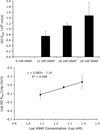Enabling the intestinal absorption of highly polar antiviral agents: ion-pair facilitated membrane permeation of zanamivir heptyl ester and guanidino oseltamivir
- PMID: 20536260
- PMCID: PMC3496398
- DOI: 10.1021/mp100050d
Enabling the intestinal absorption of highly polar antiviral agents: ion-pair facilitated membrane permeation of zanamivir heptyl ester and guanidino oseltamivir
Abstract
Antiviral drugs often suffer from poor intestinal permeability, preventing their delivery via the oral route. The goal of this work was to enhance the intestinal absorption of the low-permeability antiviral agents zanamivir heptyl ester (ZHE) and guanidino oseltamivir (GO) utilizing an ion-pairing approach, as a critical step toward making them oral drugs. The counterion 1-hydroxy-2-naphthoic acid (HNAP) was utilized to enhance the lipophilicity and permeability of the highly polar drugs. HNAP substantially increased the log P of the drugs by up to 3.7 log units. Binding constants (K(11(aq))) of 388 M(-1) for ZHE-HNAP and 2.91 M(-1) for GO-HNAP were obtained by applying a quasi-equilibrium transport model to double-reciprocal plots of apparent octanol-buffer distribution coefficients versus HNAP concentration. HNAP enhanced the apparent permeability (P(app)) of both compounds across Caco-2 cell monolayers in a concentration-dependent manner, as substantial P(app) (0.8-3.0 x 10(-6) cm/s) was observed in the presence of 6-24 mM HNAP, whereas no detectable transport was observed without counterion. Consistent with a quasi-equilibrium transport model, a linear relationship with slope near 1 was obtained from a log-log plot of Caco-2 P(app) versus HNAP concentration, supporting the ion-pair mechanism behind the permeability enhancement. In the rat jejunal perfusion assay, the addition of HNAP failed to increase the effective permeability (P(eff)) of GO. However, the rat jejunal permeability of ZHE was significantly enhanced by the addition of HNAP in a concentration-dependent manner, from essentially zero without HNAP to 4.0 x 10(-5) cm/s with 10 mM HNAP, matching the P(eff) of the high-permeability standard metoprolol. The success of ZHE-HNAP was explained by its >100-fold stronger K(11(aq)) versus GO-HNAP, making ZHE-HNAP less prone to dissociation and ion-exchange with competing endogenous anions and able to remain intact during membrane permeation. Overall, this work presents a novel approach to enable the oral delivery of highly polar antiviral drugs, and provides new insights into the underlying mechanisms governing the success or failure of the ion-pairing strategy to increase oral absorption.
Figures









Similar articles
-
Increasing oral absorption of polar neuraminidase inhibitors: a prodrug transporter approach applied to oseltamivir analogue.Mol Pharm. 2013 Feb 4;10(2):512-22. doi: 10.1021/mp300564v. Epub 2013 Jan 4. Mol Pharm. 2013. PMID: 23244438 Free PMC article.
-
Intramolecular ion-pair prodrugs of zanamivir and guanidino-oseltamivir.Bioorg Med Chem. 2011 Aug 15;19(16):4796-802. doi: 10.1016/j.bmc.2011.06.080. Epub 2011 Jul 1. Bioorg Med Chem. 2011. PMID: 21778065
-
Quasi-equilibrium analysis of the ion-pair mediated membrane transport of low-permeability drugs.J Control Release. 2009 Jul 1;137(1):31-7. doi: 10.1016/j.jconrel.2009.02.018. Epub 2009 Mar 2. J Control Release. 2009. PMID: 19264104
-
Synthetic approaches to the neuraminidase inhibitors zanamivir (Relenza) and oseltamivir phosphate (Tamiflu) for the treatment of influenza.Chem Rev. 2009 Sep;109(9):4398-438. doi: 10.1021/cr800449m. Chem Rev. 2009. PMID: 19537777 Review. No abstract available.
-
Antiviral drugs for influenza 2012-2013.Med Lett Drugs Ther. 2012 Dec 10;54(1405):97-8. Med Lett Drugs Ther. 2012. PMID: 23223245 Review. No abstract available.
Cited by
-
Combined use of phospholipid complexes and self-emulsifying microemulsions for improving the oral absorption of a BCS class IV compound, baicalin.Acta Pharm Sin B. 2014 Jun;4(3):217-26. doi: 10.1016/j.apsb.2014.03.002. Epub 2014 Apr 29. Acta Pharm Sin B. 2014. PMID: 26579386 Free PMC article.
-
Oral Administration and Detection of a Near-Infrared Molecular Imaging Agent in an Orthotopic Mouse Model for Breast Cancer Screening.Mol Pharm. 2018 May 7;15(5):1746-1754. doi: 10.1021/acs.molpharmaceut.7b00994. Epub 2018 Apr 26. Mol Pharm. 2018. PMID: 29696981 Free PMC article.
-
Towards Effective Antiviral Oral Therapy: Development of a Novel Self-Double Emulsifying Drug Delivery System for Improved Zanamivir Intestinal Permeability.Pharmaceutics. 2023 Oct 23;15(10):2518. doi: 10.3390/pharmaceutics15102518. Pharmaceutics. 2023. PMID: 37896277 Free PMC article.
-
Molecular basis for failure of "atypical" C1 domain of Vav1 to bind diacylglycerol/phorbol ester.J Biol Chem. 2012 Apr 13;287(16):13137-58. doi: 10.1074/jbc.M111.320010. Epub 2012 Feb 18. J Biol Chem. 2012. PMID: 22351766 Free PMC article.
-
Lipophilic Salts and Lipid-Based Formulations: Enhancing the Oral Delivery of Octreotide.Pharm Res. 2021 Jun;38(6):1125-1137. doi: 10.1007/s11095-021-03063-3. Epub 2021 Jun 7. Pharm Res. 2021. PMID: 34100217
References
-
- Kasim NA, Whitehouse M, Ramachandran C, Bermejo M, Lennernäs H, Hussain AS, Junginger HE, Stavchansky SA, Midha KK, Shah VP, Amidon GL. Molecular Properties of WHO Essential Drugs and Provisional Biopharmaceutical Classification. Mol. Pharmaceutics. 2004;1:85–96. - PubMed
-
- Takagi T, Ramachandran C, Bermejo M, Yamashita S, Yu LX, Amidon GL. A Provisional Biopharmaceutical Classification of the Top 200 Oral Drug Products in the United States, Great Britain, Spain, and Japan. Mol. Pharmaceutics. 2006;3:631–643. - PubMed
-
- Lipinski CA. Drug-Like Properties and the Causes of Poor Solubility and Poor Permeability. J. Pharmacol. Toxicol. Meth. 2001;44:235–249. - PubMed
-
- Martinez MN, Amidon GL. A Mechanistic Approach to Understanding the Factors Affecting Drug Absorption: A Review of Fundamentals. Pharmacokin. and Pharmacodyn. 2002;42:620–643. - PubMed
MeSH terms
Substances
Grants and funding
LinkOut - more resources
Full Text Sources
Other Literature Sources

